Basic Operations for Scanning Originals
This section describes the basic operations for scanning originals.
1
Place the original. Placing Originals
2
Press <Scan and Send> on the Main Menu. <Main Menu> Screen
3
Specify the destination on the Scan Basic Features screen. Scan Basic Features Screen
Specifying Destinations from the Address Book
Specifying Destinations from One-Touch Buttons
Entering Destinations Manually
Specifying Destinations in the LDAP Server
Specifying Your Own E-Mail Address
Specifying Personal Folder
Specifying Destinations from the Address Book of a Mobile Device

To specify e-mail destinations as Cc or Bcc, press <Cc Bcc>  <Cc> or <Bcc>
<Cc> or <Bcc>  <Specify Destinations>
<Specify Destinations>  specify destinations.
specify destinations.
 <Cc> or <Bcc>
<Cc> or <Bcc>  <Specify Destinations>
<Specify Destinations>  specify destinations.
specify destinations.To specify multiple destinations, press <Specify Destinations> and specify an additional destination.
To delete a destination, select the destination you want to delete, and press <Delete Dest.>.
You can select a destination and press <Details> to confirm the detailed information for the destination.
You can only change destinations from <Details> specified using the New Destination and destinations obtained via an LDAP server.
If the server machine is performing the System Manager information settings, authentication between the server machine and the client machine is performed while the client machine is obtaining the Remote Address Book/one-touch buttons. Authentication is performed by matching the System Manager ID and System Manager PIN set by the server machine and client machine.
The availability of the Remote Address Book/one-touch buttons depends on the status of the System Manager information settings for the server machine and client machine, as shown below.
The availability of the Remote Address Book/one-touch buttons depends on the status of the System Manager information settings for the server machine and client machine, as shown below.
|
When the server machine is performing the System Manager information settings
|
When the client machine is performing the System Manager information settings
|
The System Manager ID and System PIN for the server machine and client machine match
|
Can use the Remote Address Book/One-Touch Button
|
|
Performing
|
Performing
|
Matches
|
Yes
|
|
Does Not Match
|
No
|
||
|
Not Performing
|
-
|
No
|
|
|
Not Performing
|
Performing
|
-
|
Yes
|
|
Not Performing
|
-
|
Yes
|
Specifying Destinations from the Address Book
1
Press <Address Book>.
2
Select the destination and press <OK>.
If an access number is set when the destination is registered, press <Access No.> and enter the access number using the numeric keys. The corresponding destination is displayed in the Address Book.
To use the Remote Address Book, press <To Remote Address Book>. When <Change Address Book> is displayed, press <Change Address Book>  <Remote>.
<Remote>.
 <Remote>.
<Remote>.
 Destination type buttons
Destination type buttonsPressing ,
,  , and
, and displays e-mail, file server, and group destinations, respectively.
displays e-mail, file server, and group destinations, respectively.
 ,
,  , and
, and displays e-mail, file server, and group destinations, respectively.
displays e-mail, file server, and group destinations, respectively. Drop-down list for selection of Address Book types
Drop-down list for selection of Address Book typesWhen you are logged in to the machine with personal authentication management, selecting <Personal Address List> displays your personal Address Book. You can also display dedicated user group address lists (User Group Address Lists) in which you are included.
 <Search by Name>
<Search by Name>Enables you to search the destination by the name you are entering.
 Search buttons by first letter
Search buttons by first letterEnables you to narrow down a search by the first letter of the destination name.
 |
|
To use the Remote Address Book, it is necessary to configure the server machine settings. Set to open the Remote Address Book externally on the server machine.
|
Back to Top
Specifying Destinations from One-Touch Buttons
1
Press <One-Touch>.
2
Select the desired one-touch button and press <OK>.
To specify the destination using a one-touch button number (one-touch number), press  and enter the number for the desired one-touch button.
and enter the number for the desired one-touch button.
 and enter the number for the desired one-touch button.
and enter the number for the desired one-touch button.To use the Remote Address Book, press <To Remote Address Book>.

 |
|
The destinations registered in the one-touch buttons of the server machine are updated in the following times:
When a fax job has been sent on the client machine
When you press the Reset key on the client machine
When Auto Reset is activated on the client machine
|
Back to Top
Entering Destinations Manually
You can specify destinations manually that are not registered in the Address Book or one-touch buttons.
1
Press <New Destination> and select <E-Mail> or <File>.

Selecting <I-Fax> enables you to send scanned documents as a fax via the Internet.
2
Specify the destination and press <OK>.

You can press <Register to Address Book> to register the entered destination. Set the required conditions, and specify <Name> and <Address List>. For information on the settings, see Registering Destinations in the Address Book.
If you select <File> in step 1, specify the settings such as the IP address of a file server and the path of the save location folder. For details about the setting items, consult your network administrator.
Back to Top
Specifying Destinations in the LDAP Server
You can search and specify destinations registered in the LDAP server.
1
Press <Address Book>.
2
Press <To LDAP Server>.

When <Change Address Book> is displayed, press <Change Address Book>  <LDAP Server>.
<LDAP Server>.
 <LDAP Server>.
<LDAP Server>.If the network password input screen is displayed, enter the user name and password and press <OK>.
3
When searching destinations in the LDAP server, press either <Search by Conditions> or <Search by Name>.

To display all the destinations in the LDAP server, proceed to step 4.
 When searching by conditions
When searching by conditions
Press <Search by Conditions>, specify the search conditions on the screen, and press <Start Searching>.

 Search categories
Search categoriesSelect a criterion to search for destinations from name, e-mail address, organization name, and organization unit (department name, etc).
 Search conditions
Search conditionsSelect a search condition such as a destination name that contains "John" and a department name that begins with "Development."
 Search characters
Search charactersPress <Set> and enter search characters for the search condition.

To search with multiple conditions
You can search destinations with multiple conditions. Specify the first search condition, press <Add Search Condition>, and then select <or> or <and> for the next condition.
To change conditions and search again
Press <Delete> to delete the specified contents, and specify the conditions again.
 When searching by name
When searching by name
Press <Search by Name>  enter the text to search
enter the text to search  press <OK>.
press <OK>.
 enter the text to search
enter the text to search  press <OK>.
press <OK>.
You can specify attributes used when performing "Search by Name" for a destination from the LDAP server. Configuring to "Search by Name" for LDAP Searches
4
Select the destination and press <OK>.

Back to Top
Specifying Your Own E-Mail Address
You can specify the e-mail address of the user who is logged in to the machine with personal authentication management.
1
Press <Send to Myself>.
The e-mail address of the user who is logged in to the machine is specified as the destination.
Back to Top
Specifying Personal Folder
You can specify the personal folder of the user who is logged in to the machine with personal authentication management.
1
Specify <Personal Folder>.
The personal folder of the user who is logged in to the machine is specified as destination.
Back to Top
Specifying Destinations from the Address Book of a Mobile Device
You can specify a destination from the address book of a mobile device.
To use this function, you must install the "Canon PRINT Business" application to your mobile device. Utilizing the Machine through Applications
To use this function, you must install the "Canon PRINT Business" application to your mobile device. Utilizing the Machine through Applications
1
Connect to the mobile device. Linking with Mobile Devices
2
Send the address from the mobile device to the machine.
For detailed information on operations using the mobile device, see "Canon PRINT Business Help."

You can send information including the subject, message body, and file name from the mobile device to the machine. Utilizing the Machine through Applications
Back to Top
4
Specify the scan settings as necessary.
Selecting a File Format
Selecting Resolution
Specifying the Scanning Size of Originals
Selecting Color Scan/Black & White Scan
Scanning Both Sides of Originals
Specifying the Orientation of the Original
Selecting a File Format
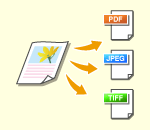 |
|
Scanned originals are converted into electronic files such as PDF. Select the file format according to your purposes and environment of use.
|
1
Press the setting button for file format.

2
Select the file format.
If you select <PDF>, <XPS>, or <OOXML>, you can specify various additional settings.
If you selected <JPEG> or <TIFF>, there are no further operations. Press <OK>.

<JPEG>
This file format is suitable for photographic originals. Multiple-page originals will be divided into one file per page.
<TIFF>
This file format is suitable for graphical originals. Originals are scanned in black and white.
<PDF>
This file format is suitable for text documents. Documents can be displayed in the same way on any computer, regardless of the operating system used.
<XPS>
This is a file format taken from Windows Vista. Documents can be displayed in the same way on any Windows computer, regardless of the operating system used.
<OOXML>
This file format can be edited in Microsoft Office Word or PowerPoint. The optional "Universal Send Advanced Feature Set" is required for this format.
 |
|
PDF (Trace & Smooth) is only valid with the following settings:
Select Color: Color mode other than the Black-and-White mode
Resolution: 300 dpi x 300 dpi
PDF (Compact) or XPS (Compact) is only valid with the following settings:
Select Color: Color mode other than the Black-and-White mode
Resolution: 300 dpi x 300 dpi
<Word> documents to which <OOXML> is set can only be sent with the following settings.
Select Color: Color mode other than the Black & White mode
Resolution: 300 dpi x 300 dpi
<PowerPoint> documents to which <OOXML> is set can only be sent with the following settings.
Select Color: Color mode other than the Black & White mode
Resolution: 300 dpi x 300 dpi or 600 dpi x 600 dpi
If you select PDF (Trace & Smooth), the machine may be unable to recognize which parts of the scanned document are text and line drawings, depending on the scanned document.
The text and background of PDF files containing outline data may become misaligned, and text and line drawings may not be displayed, depending on the version of Adobe Illustrator used to open the PDF.
When creating files by pagesTo scan a multiple-page original and save each page as a separate file instead of saving all pages as a single file, press <Divide into Pages>.
To specify the number of pages to include in each file, after pressing <Divide into Pages>, specify the desired number of pages. To save each page as a separate file, specify <1> for the number of pages.
If you select <TIFF/JPEG>, each page will automatically be created as a separate file according to the Select Color mode.
When Black & White is set for the Select Color mode: TIFF
When a setting other than Black & White is set for the Select Color mode: JPEG
You cannot specify the number of pages to include in one file if you are currently using the <Scan and Store> function.
|
|
TIPS
|
|
Installing an option can expand functions for scanning to create files. For information on the required optional products and the file formats, see System Options.
|
Back to Top
Selecting Resolution
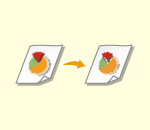 |
|
To scan an original clearly, increase the resolution. To reduce the file size, decrease the resolution.
|
1
Press the setting button for resolution.

2
Select the resolution and press <OK>.
Depending on the file format you are selecting, the resolution that you can select is limited.

When using a resolution of 200 dpi x 400 dpi, 400 dpi x 400 dpi, and 600 dpi x 600 dpi, you can only send using <Black & White>.
Back to Top
Specifying the Scanning Size of Originals
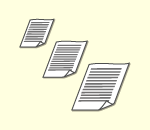 |
|
If you are scanning free size/highly transparent originals, or the edge of image is missing when scanning, you need to manually specify the scanning size.
|
1
Press the setting button for scanning size.

2
Select the scanning size and press <OK>.
To scan the original in A4, select <A4>.
 When scanning a special size document, such as officio
When scanning a special size document, such as officio
Press <Other Size>, and select the paper size.
 When specifying the values of scanning size
When specifying the values of scanning size
Place the original on the platen glass, select <Custom>, and enter the height and width of the original.
 |
To register the scanning sizeIf you frequently specify the scanning size with the same values, register the size in <Custom>
 <Register Size> to quickly recall the setting for convenience. <Register Size> to quickly recall the setting for convenience. |
Back to Top
Selecting Color Scan/Black & White Scan
 |
|
You can specify color when scanning original.
|
1
Press the setting button for color.

2
Select the color and press <OK>.
Depending on the file format you are selecting, the setting item that you can select is limited.

 <Auto (Color/Gray)>
<Auto (Color/Gray)>Determines automatically what color is used for scanning according to the color of an original. For example, color pages are scanned in color, and monochrome pages are scanned in grayscale (monochrome gradation).
 <Auto (Color/B&W)>
<Auto (Color/B&W)>Determines automatically what color is used for scanning according to the color of an original. For example, colored pages are scanned in color, and monochrome pages are scanned in black and white. Select this mode when text is faint with <Auto (Color/Gray)>, or when the original mainly consists of text.
 <Full Color>
<Full Color>Scans in color regardless of a document's color. Depending on the state of the color original, it may be detected as black and white when scanned, even if you set <Auto (Color/B&W)>. To avoid this, set the color mode to <Full Color>.
 <Black & White>
<Black & White>Scans in black and white regardless of an original's color. This mode is automatically set for the TIFF file format.
 <Grayscale>
<Grayscale>Scans in grayscale regardless of an original's color. This mode uses different shades of color, such as black, dark gray, gray, light gray, and white, making color look more natural and beautiful compared with <Black & White>.

If a black-and-white original is scanned in the Full Color mode, it is counted as a color scan.
If you select <JPEG> as the file format, <Black & White> is changed to <Grayscale>.
If you select <TIFF> as the file format, <Black & White> is set.
If <OOXML> is selected as the file format, you can only send in <Auto (Color/Gray)>, <Full Color>, or <Grayscale>.
If the destination is an I-fax address or a group address that includes an I-fax address, the scanned document is always sent in the Black-and-White mode.
Back to Top
Scanning Both Sides of Originals
 |
|
The machine can automatically scan both the front and back sides of an original.
|
 |
|
Place the original in the feeder. Specify the orientation to match that of the loaded original.
If you want to scan each side of the 2-sided originals placed on the platen glass, specify the <Job Build> settings. Sending/Saving Separately Scanned Documents Together (Job Build)
|
1
Press <2-Sided Original>.
2
Select <Book Type> or <Calendar Type> and press <OK>.

Select <Book Type> for originals whose images on the front and back sides face the same direction, or <Calendar Type> for originals whose images on the front and back sides face in opposite directions.
Back to Top
Specifying the Orientation of the Original
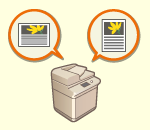 |
You can specify the orientation of an original placed on the platen glass or into the feeder as horizontal or vertical.
|
1
Press <Options>  <Original Content Orientation>.
<Original Content Orientation>.
 <Original Content Orientation>.
<Original Content Orientation>.2
Select the orientation of the original.

Select <Top at Far Edge> for horizontally-oriented originals, or <Top at Side Edge> for vertically-oriented originals.
|
For Originals in Portrait Orientation
|
|||||
|
Type of Original
|
Platen Glass
|
Feeder
|
|||
 |
 |
 |
|||
|
For Originals in Landscape Orientation
|
|||||
|
Type of Original
|
Platen Glass
|
Feeder
|
|||
 |
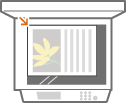 |
 |
|||
3
Press <OK>.
Back to Top
4
Press  .
.
 .
.Originals are scanned and sending/saving starts.
To cancel scanning, press <Cancel> or 
 <Yes>.
<Yes>.

 <Yes>.
<Yes>. When <Press the [Start] key to scan the next original.> is displayed
When <Press the [Start] key to scan the next original.> is displayed
Place the next original to scan and press  . When scanning all of the originals is complete, press <Start Sending> to send/save the file.
. When scanning all of the originals is complete, press <Start Sending> to send/save the file.
 . When scanning all of the originals is complete, press <Start Sending> to send/save the file.
. When scanning all of the originals is complete, press <Start Sending> to send/save the file.Depending on the communication settings, you may be prompted to enter the user name and password. Setting E-mail/I-Fax Communication
 |
To immediately cancel a job that is being sentIf you press
 on the control panel while a job is being sent, the message <Is it OK to cancel the following Send job?> appears. Press <Yes> to cancel sending. on the control panel while a job is being sent, the message <Is it OK to cancel the following Send job?> appears. Press <Yes> to cancel sending.You can select <Latest Received Job> or <Job Being Sent> to choose the job to cancel. <Job to Cancel When Stop is Pressed>
Press
 when there are multiple send jobs to display the screen for selecting the send job to cancel. If the send job you want to cancel is not displayed, press <Check Other Jobs> to display <Send Jobs>. Select the job that you want to cancel, and press <Cancel>. when there are multiple send jobs to display the screen for selecting the send job to cancel. If the send job you want to cancel is not displayed, press <Check Other Jobs> to display <Send Jobs>. Select the job that you want to cancel, and press <Cancel>.To check the statuses for sent/saved documentsOn the <Status Monitor/Cancel> screen, you can check the statuses for sent/saved documents. This screen enables you to send/save documents again or cancel sending/saving after checking the statuses. Checking Status and Log for Scanned Documents
When <Display Notification When Job Is Accepted> is set to <On>, the <Status Monitor/Cancel> screen can be displayed from the following screen that is shown after a send job is received. <Display Notification When Job Is Accepted>
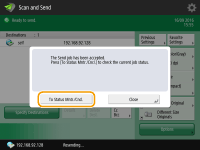 To print the report for the results of sending/savingOn the Scan Basic Features screen, pressing <Options>
 <TX Report> enables you to set to automatically print the report listing the results of sending/saving. <TX Report> enables you to set to automatically print the report listing the results of sending/saving.To set this for each job from <Options>, it is necessary to select <For Error Only> or <Off> in <TX Report>, and then set <Allow Printing from Options> to <On>.
File nameWhen a file is sent/saved, its file name is automatically set based on the following format. You can change the setting so that a different name can be assigned. Setting a File Name
When sending by e-mail
"Job numbers (four digits)_page numbers (three digits).file extension name" format, such as "1042_001.jpg" When saving in a file server
"The year, month, day, hour, minute, and second the file is saved (14 digits).file extension name" format, such as "20151030133541.jpg" E-mail subjectThe subject entered in <Default Subject> is automatically set (<Default Subject>). If you specify a different subject, change the setting, or specify each time you send an e-mail (Specifying E-Mail Settings).
When multiple sheets are fedScanning is stopped and the message is displayed on the screen. Follow the instructions to clear the jam.
When you have cleared the jam, the resume job screen is displayed. If the machine mistakenly detects multiple sheet feeding, press <Do Not Detect Multi. Sheet Feed> to resume scanning. To set the machine in advance to not notify you of multiple sheet feeding, perform one of the following operations.
Each time you send/save a document, press <Options> on the Scan Basic Features screen
 select <Detect Feeder Multi Sheet Fd.> to disable the setting. select <Detect Feeder Multi Sheet Fd.> to disable the setting.Set <Set Detection of Feeder Multi. Sheet Feed as Default> to <Off> (<Set Detection of Feeder Multi. Sheet Feed as Default>).
|
|
TIPS
|
Determining the top and bottom of the originalYou can set the orientation of the document before scanning so that its top and bottom are positioned correctly when the sent/saved file is displayed on a computer.
Press <Original Content Orientation> on the Scan Basic Features screen
 <Top at Far Edge> <Top at Far Edge>  <OK>. <OK>.Specifying multiple destinations including faxesSetting <Enable Fax in Scan and Send Function> to <On> enables you to specify fax destinations from the Scan Basic Features screen (<Display Fax Function>). This setting is useful for specifying multiple destinations including faxes, such as when saving a copy of a sent fax in a file server.
Checking scanned images before sending/savingYou can check scanned images on the preview screen before sending/saving. Checking Scanned Originals Before Sending/Saving (Preview)
Registering frequently used settingsYou can combine frequently used destinations and scan settings into a button of the machine for later use. By pressing the registered button when scanning originals, you can quickly complete your settings. Registering a Combination of Frequently Used Functions
|